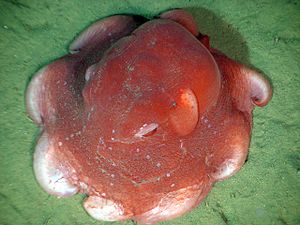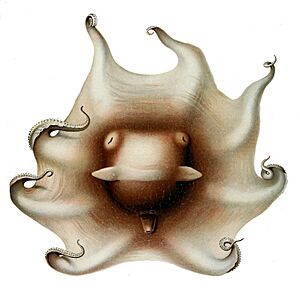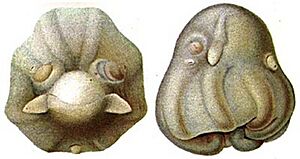Umbrella octopus facts for kids
Quick facts for kids Umbrella octopuses |
|
|---|---|
 |
|
| Opisthoteuthis californiana | |
| Scientific classification |
|
| Kingdom: | Animalia |
| Phylum: | Mollusca |
| Class: | Cephalopoda |
| Order: | Octopoda |
| Suborder: | Cirrina |
| Family: | Opisthoteuthidae Verrill, 1896 |
| Genera | |
|
Opisthoteuthis |
|
Umbrella octopuses are fascinating creatures that live deep in the ocean. Their scientific name, Opisthoteuthidae, comes from ancient Greek words meaning "back" and "squid." These octopuses get their common name because they have a special web of skin connecting their arms. When they spread their arms out, they look a lot like an open umbrella! They are a type of pelagic octopus, which means they live in the open water, not usually on the seafloor.
Contents
What Do Umbrella Octopuses Look Like?
Umbrella octopuses have a unique appearance because of the web of skin between their arms. This web makes them look like an umbrella when their arms are spread wide. They also have a broad, U-shaped internal shell. This shell helps support small fins on their body, which is called the mantle. These fins are not very strong for swimming. Instead, they act like stabilizers, helping the octopus keep its balance as it moves through the water. They often move with a gentle, pulsing motion of their arms and web, similar to a jellyfish.
The octopus's mouth and its webbed arms are located below its main body. Their outer skin is very delicate. If it gets damaged, white spots can appear on their skin. Even though they are part of a group called cirrates, which usually have an "intermediate web," umbrella octopuses don't have one. Instead, they use the web between their arms to create a similar effect. This is what gives the outer edges of their arms a wavy, umbrella-like shape.
How Do Umbrella Octopuses Behave?
Umbrella octopuses have some interesting ways to protect themselves and rest in their deep-sea home.
Staying Safe: Defense Mechanisms
Since umbrella octopuses don't have an intermediate web, they have a clever way to defend themselves. They stretch the web between their arms as wide as possible. Then, they curve the outer edges of their arms inwards, making them touch the ground. They also extend their fins out to the sides to help them stay balanced. They can hold this "umbrella" position for several minutes to hide or deter predators.
Another defense they use is called "web-inversion." This is when they turn their arms upwards. Their web and mouth area then face outwards. They might face the seafloor, or the octopus may lie on its side. Scientists have noted that these defensive moves might also be positions they use when they are eating. However, it's also possible they do this when they feel stressed, like when they are observed in an aquarium.
Taking a Break: Resting Habits
When umbrella octopuses want to rest on the seafloor, they use two main methods: "bottom-resting" or "flat-spreading."
When "bottom-resting," the octopus rests close to the seafloor. It lifts its main body (mantle) and curves the edges of its arms inwards. Only the tips of its arms make contact with the ground. Its fins are stretched out to the sides to help it stay balanced.
When "flat-spreading," they spread their arms and web out flat, parallel to the seafloor. The edges of their arms are still curved inwards. Their head points slightly backward, and their fins are used to keep them steady.
Where Do Umbrella Octopuses Live?
Umbrella octopuses are true deep-sea explorers! They live in the very cold, dark parts of the ocean. They have been found in places like the Clipperton-Clarion Fracture Zone in the Pacific Ocean. Here, they live at incredible depths of about 4,800 meters (that's almost 3 miles down!). They also live in the South China Sea. These octopuses usually stay between 3,000 and 4,000 meters below the surface. They often hover just above the ocean floor.
Classifying Umbrella Octopuses
Scientists group living things into categories to understand them better. This is called taxonomy. The family of umbrella octopuses, called Opisthoteuthidae, used to be thought of as having just one main group, or genus, named Opisthoteuthis.
However, scientists have recently learned more about these octopuses. They looked at differences in male specimens, for example. Because of these new findings, the family Opisthoteuthidae is now divided into three different genera:
- Genus Opisthoteuthis
- Genus Insigniteuthis
- Genus Exsuperoteuthis
These new classifications help us understand the amazing diversity within the umbrella octopus family!



